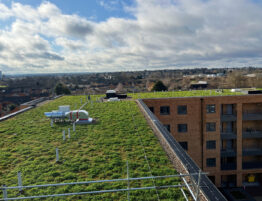
There was a time when the idea of including a flat roof in a building design would have been considered risky, largely because of the kind of roofing materials used during the 1950s and 60s which proved to be not that durable and had a reputation for leaks.
However, the technology has moved on so much since then and today we have flat-roofing solutions which provide exceptional waterproofing, are resistant to tear or puncture and have a much longer lifespan than their predecessors.
Perhaps the best thing about modern flat-roofing is that, providing it has been professionally installed, it should only ever require some simple routine maintenance. With the Autumn bringing leaves and debris onto our roofs, now is the time to get that maintenance done. Follow our advice in this week’s blog.
Your guide to Autumn roof care
While many of us enjoy the bold colours that the natural world offers us in Autumn, the shedding of leaves, sudden downpours, changes in temperature and all the debris that gets blown around in the wind at this time of year can cause some issues for your roof, guttering and drainage. Carrying out some simple checks and preventative measures now is better than dealing with a bigger problem down the line. Here’s our 3-point ‘clean, cut and check’ guide:
1. Clean up
It’s best practice to remove any dirt, leaves and debris from the roof, gutters and drains at regular intervals of the year, but this is probably most important in Autumn when they can start to build up.
Make sure to stay safe while up on the roof and one way to avoid actually walking across an expanse of roofing is to use a leaf blower. While this is a good option in terms of both safety and for preventing damage, it is not recommended in cases where the roof has been particularly designed as a usable outdoor space (e.g. a roof garden).
2. Cut back
If you spot any nearby trees that have branches overhanging the roof (or look likely to overhang in the near future), cut them back. This will help to avoid your roof and its drainage system from becoming clogged up with leaves or twigs. Also look out for creeping plants as these can cause damage if they wind their way up to, or over, the roof.
3. Check for surface issues
With flat-roofing, you need to watch out for three main issues:
- Blistering – If air is trapped between the substrate layers in the roofing, when it heats up it can cause pockets that can then puncture.
- Splitting – Freeze thawing, stress, pressure and poor workmanship can all cause parts of the roof surface to split.
- Ponding – If conditions are wet, look for standing pools of water and if it’s a dry day, look for a concave area with a watermark around it.
If you spot any of these issues, there are solutions available, for example installing hoppers or a water pump to deal with ponding. However, while many people are capable of carrying out their own roofing checks and a bit of simple maintenance, when it comes to making roofing repairs, our advice would be to seek professional help. As well as taking the work off your hands, they’ll have a better understanding of the problem and the right health and safety measures in place.
[Please note that Sheriff Construction can only provide roofing repair, leak testing and maintenance services for commercial clients who have already used us for their flat-roofing installation.]
Give your roof the long life it deserves
Although modern flat-roofing systems are durable and long-lasting, minimal maintenance is not the same as no maintenance! They do need a little bit of attention to remain functional and looking good so it’s a good idea to carry out this type of cleaning and maintenance checks at least twice a year. Pencil in Autumn and Spring for this work but remember there could be other times when the roof may need additional care (e.g. after a heavy storm or snowfall).
Take time to do this, avoid a repair and give your roof the long life it was made for.
16.11.2022
Feature image: Pixabay








